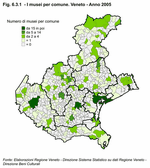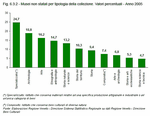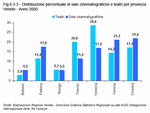The culture and tourism sectors are closely related as the historic and artistic heritage and cultural initiatives in the Veneto, with its rich and varied history, strongly attract tourists. The link, then, is one of the main factors for investment and also for the promotion and development of the competitiveness of tourism in the region.
For some years, of all tourism sectors in the Veneto, the historical cities have seen the greatest increase in visitors, in 2006 up 7% on the previous year and the driving force behind tourism in the region.
This success is due to the importance, beauty and uniqueness of the region's architecture, its monuments and museums, not to mention the growing number of cultural events organised throughout the Veneto.
Cultural heritage
There is a particularly wide range of museums in the region. In 2005 there were 340 non-state museums in the region, as well as about 100 other museums that have not been taken into account here as they were newly opened, closed for restoration, not open continuously, or are small in terms of size or content. Another 14 museums, museum circuits, and state-owned archeological areas should also be added.
There are several types of museums where one can find items and collections on display that bear witness to art, archaeology, the environment and nature, ethnography and cultures, history and the Great War, science and technology, the territory and local production. (Figure 6.3.1) and (Figure 6.3.2)
The non-state museums are distributed relatively evenly over the provinces, varying from 13.8% in Belluno and Treviso to 17.4% in Padova. The only exception is Rovigo, which is home to only 5.9% of the region's museums.
The provinces of Padova and Vicenza in particular have the highest number of specialised museums, that is those that hold material related to the production of a specific craft or industry, or a single category of items. Padova also stands out, along with Venezia, for its density of art museums, while Vicenza and Verona are home to most of the archaeological museums. Treviso is mainly home to specialised and art museums, while Rovigo and Belluno show an interest in ethnography and anthropology.
Apart from the collections on display, the buildings themselves are of significant artistic and cultural value: 21.5% of the museums in the Veneto are housed in historic buildings and 12.4% in churches or religious buildings.
Of the 14 state museums, 10 are in the province of Venezia, and 6 of these are in Venezia itself. Two out of the fourteen are classed as "Monument", Villa del Bene di Dolcè (Verona) and the Museo Nazionale di Villa Pisani di Stra (Venezia), and two, the Area Archeologica di Feltre and Basilica Paleocristiana in Concordia Sagittaria, are archaeological areas.
In 2005, there were over 983 thousand visitors to state museums in the region, up 1.2% on the previous year.
Data from Federculture about the most important Italian museums, both state-run and privately-run, reveal that in 2006 the Palazzo Ducale established itself as the most visited non-archaeological Italian museum. It was visited by just under one and a half million people, up 3.6% on the previous year.
Libraries, another important sector of historic-artistic heritage, are also the focus of investment, with the aim of modernising the buildings and the services on offer. The ICCU, Istituto Centrale per il Catalogo Unico, has revealed that in 2005, 916 libraries in the Veneto were open to the public, 7.4% of the national total. From an administrational point of view, 63% are run by local authorities, 14% by universities and 8% by Church authorities. There are also 4 state libraries, 3 in the province of Padova and 1 in Venezia, that are run by the Ministry for Cultural Assets and Activities.
Cultural activities and the performing arts
While many tourists choose the cities of art in the Veneto for their historical and cultural value, several tourists are also attracted to our cities by temporary events such as exhibitions, festivals, the theatre and other activities. The wide range of culture in the region is mainly aimed at residents who can choose among the various events and increase their knowledge of the many artistic disciplines without having to travel too far.
In 2006 the most important exhibitions in the Veneto had over 526 thousand visitors. Initial data on exhibitions running from 2006-2007 show that there have been 1,187 visitors per day to the Picasso exhibition in Venezia, 1,211 to the Mantegna exhibition in Padova, 1,140 to the Mantegna exhibition in Verona and 710 to the "da Boccioni a Vedova" exhibition in Treviso.
During the Venice Film Festival from 30 August - 9 September 2006, the number of nights spent in the old-town centre and the Lido topped 216,000.
Other kinds of exhibitions and events attract locals and tourists alike. These include the Venice Carnival and, in the summer various towns around the Veneto put on a Notte Bianca, when shops and bars stay open all night and nocturnal theatre, music and dance shows are organised.
This general overview, then, reveals a new kind of demand for culture from both residents in the Veneto and tourists, along with the more traditional demand for museums and archaeological sites.
The Veneto is highly renowned on the national scene for its dynamic performing arts sector. The region's role is of immense significance: it holds 4th place in terms of both offer and demand, after Lombardia, Lazio and Emilia Romagna. In 2005 there were over 18,000 shows, nearly 10% at a national level, with a total of almost 3 million spectators. (Table 6.3.1)
The opera deserves a special mention. In the Veneto the Fondazione Arena is of particular importance in terms of the demand for performances and the expenditure incurred: it is thanks to this that data for the region makes up a third of the corresponding national data.
Data for theatre is also positive, with an increase in both offer and demand. The number of performances rose by 10% compared to 2004, while the number of spectators increased by 3.2%. These data indicate the considerable vitality and dynamism in the sector.
An analysis of the data available for the cinema indicate that the Veneto offers 8% of the total showings for the nation, with an increase of over 22% in the last five years.
In terms of buildings, there are 35 theatres in the Veneto, as well as 68 cinemas that host theatrical performances, and a total of 165 cinemas.
Theatres and cinemas are spread evenly over the central band of the region, with notable differences in the Provinces of Belluno and Rovigo. (Figure 6.3.3)
Sports
Sports have an important social function, promoting and supporting personal development and the chance to socialise. The economic value of the activity is also important in terms of employment policy and sports promotion.
The data for 2005 reveal that in total, a quarter of residents over three years old in the Veneto has practiced one or more sports regularly . A further 14% have occasionally practiced a sport. School children in particular do sport and physical activity: at a national level, 50% of children aged between 6 and 10 and 54% of those aged between 11 and 14.
Public attendance at sports events is another form of participation in sporting activities: in the Veneto, more than 13,000 sports events were organised and as many as 29% of the population over 6years old watched at least one sports event.
Sector development
Considerable financing is necessary to respond to the growing demand for cultural offer and to reach a high level of competitiveness in both national and international contexts.
In 2006 expenditure for Italy in the culture sector was considerably lower than for other European countries such as France, Germany, Great Britain and Spain. In addition cuts are being made to the quota of the national budget allocated to culture. While in 2002 it was 0.4%, in 2007 it decreased to 0.3%.
As far as regional authorities are concerned, the situation seems better: in 2005 3.4% of municipal budgets, 1.8% of province budgets and 0.8% of the regional budget was spent on the sector.
Investment in the sector by the Comune di Venezia was particularly good: 3.7% of total spending, higher than that of Roma (3.7%), but lower than that of Firenze (8.3%) and Torino (6.8%).
From this it has emerged that local authorities alone are not able to offer the funding necessary to preserve the historic and artistic heritage of our region, or to continually update the cultural offer. The participation of private bodies is, therefore, strategically necessary.
Greater investment in the sector, as mentioned above, is also an opportunity for development for the tourism sector. An analysis of foreign tourists in Italy, carried out by UIC in 2006, confirms the increase of nights spent by cultural tourists in recent years and gives an outline of their general profile. This kind of visitor usually comes from non-European countries, stays longer in our cities, visits the highest number of provinces and, on average, spends more on their holidays (over €100 a day per person).
Initiatives and cultural heritage offer an important opportunity to attract tourists from a wider range of countries and to increase profits in the tourism sector. In addition, the so-called cultural tourists visit throughout the year, meaning that tourist inflow is not concentrated in any one season, which guarantees the continuity of tourist activity. Finally, the organisation of cultural events, if they take into consideration individual circumstances around the region and the capacity for local development, can enhance appreciation of less well-known places, drawing an excess of tourists away from the most visited areas that suffer the greatest accommodation and environmental problems.
It is important to be aware of the need for funding to support and develop the region's cultural sector. This would benefit the entire community as well as the economy in that it would enhance the offer of cultural services as well as the offer of the Veneto's specialised tourism.


 Index
Index 


